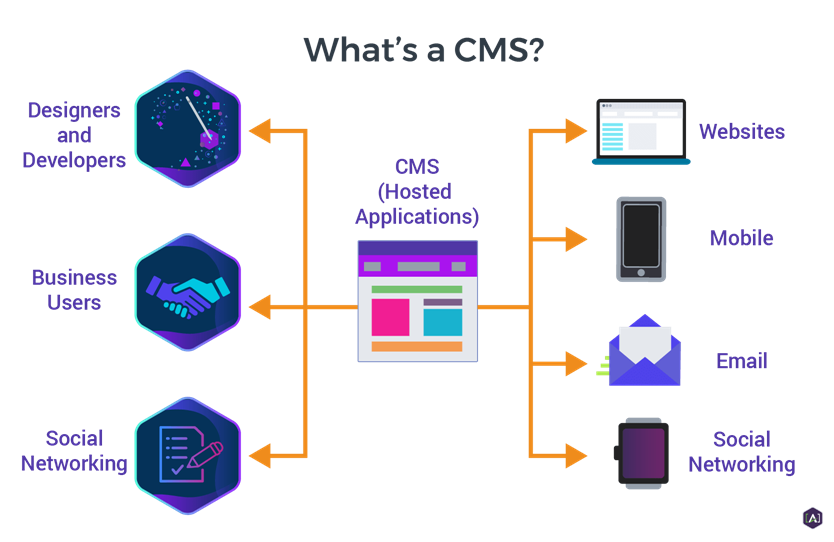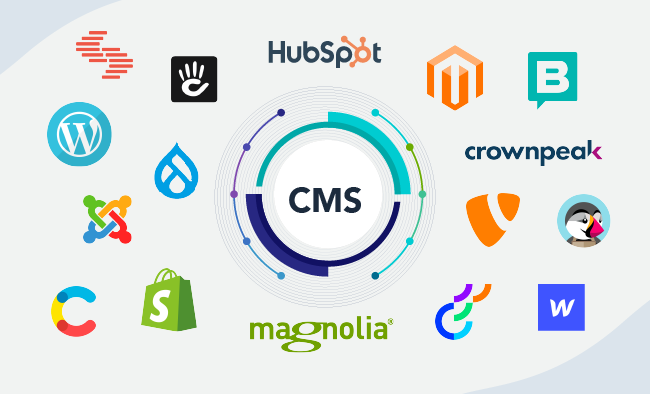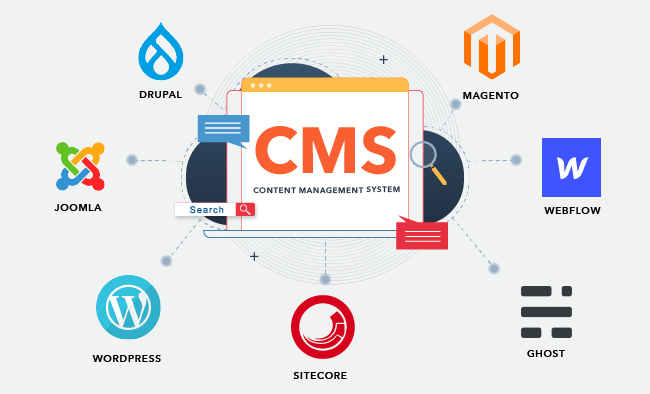CMS Content Management System: Boost Web Presence
A CMS, or Content Management System, is software that allows users to create, manage, and modify digital content easily. It simplifies the process of building and maintaining websites without extensive technical skills.
A Content Management System streamlines the way you handle digital content. Businesses and individuals use CMS platforms to create websites, blogs, and online stores efficiently. These systems offer user-friendly interfaces, making it simple for anyone to publish and edit content.
Popular CMS options like WordPress, Joomla, and Drupal provide customizable templates and plugins, enhancing functionality and design. With a CMS, users can focus on content creation rather than coding, making it an ideal choice for those who want to establish an online presence quickly. The flexibility and scalability of CMS platforms support growth as needs evolve.

Credit: simplea.com
Key Benefits Of Using A Cms
A Content Management System (CMS) offers many advantages. These benefits help businesses manage their online content easily. Let’s explore the key benefits of using a CMS.
Enhanced Productivity
Using a CMS boosts productivity for teams. Here’s how:
- Simple interface for easy content creation.
- Pre-built templates save design time.
- Multiple users can edit content simultaneously.
A CMS reduces the need for technical skills. Users can focus on content instead of coding. This leads to quicker updates and changes.
Improved Content Consistency
Consistency is vital for any website. A CMS ensures uniformity across all content. Here are key features that help:
| Feature | Benefit |
|---|---|
| Reusable Templates | Maintain a consistent look and feel. |
| Style Guides | Ensure uniform language and tone. |
| Version Control | Track changes and maintain original content. |
With these features, a CMS helps maintain brand integrity. Consistent content builds trust with your audience.
Popular Cms Platforms
Content Management Systems (CMS) have changed how we create websites. They make it easy for anyone to build and manage a site. Many platforms exist, each with unique features. Let’s explore some of the most popular CMS options available today.
WordPress And Its Dominance
WordPress is the most popular CMS globally. It powers over 40% of all websites. This platform is user-friendly and highly customizable.
- Ease of Use: Simple interface for beginners.
- Themes and Plugins: Thousands of options to enhance functionality.
- SEO Friendly: Built-in features for better search rankings.
- Community Support: Large community for help and resources.
WordPress is ideal for blogs, portfolios, and e-commerce. Its flexibility suits both small and large projects. Users can create stunning websites without coding skills.
Drupal, Joomla, And Other Alternatives
While WordPress leads, other CMS platforms are worth considering. Each alternative has unique strengths and features.
| CMS Platform | Best For | Key Features |
|---|---|---|
| Drupal | Complex Websites |
|
| Joomla | Social Networking Sites |
|
| Squarespace | Visual Content |
|
Choose a CMS that fits your needs. Each platform offers different benefits. Consider your project goals and technical skills before deciding.
Cms For Seo Optimization
Using a Content Management System (CMS) can greatly enhance your SEO optimization efforts. A good CMS offers various tools and features that help improve your website’s visibility in search engines. Let’s explore how a CMS can boost your SEO.
Built-in Seo Tools
Most modern CMS platforms come with built-in SEO tools. These tools simplify the optimization process. Here are some common features:
- Meta Tags: Easily add title and description tags.
- URL Structure: Create SEO-friendly URLs.
- Image Optimization: Add alt text and optimize images for faster loading.
- XML Sitemaps: Automatically generate sitemaps for better indexing.
These tools help you implement SEO best practices without technical knowledge.
Best Practices For Content Ranking
To rank higher in search results, follow these best practices:
- Keyword Research: Use tools to find relevant keywords.
- Quality Content: Write engaging and informative content.
- Internal Linking: Link to other pages on your site.
- Mobile Optimization: Ensure your site is mobile-friendly.
- Page Speed: Optimize images and scripts for faster loading.
Implementing these practices boosts your site’s chances of ranking higher.
| SEO Tool | Benefit |
|---|---|
| Meta Tags | Improve click-through rates from search engines. |
| URL Structure | Enhance user experience and search visibility. |
| Image Optimization | Faster page loading and better ranking. |
| XML Sitemaps | Help search engines index your site efficiently. |
Use these tools and practices. They lead to better SEO results.
Customization And Flexibility
Customization and flexibility are vital features of a Content Management System (CMS). They allow users to create unique websites that meet specific needs. A flexible CMS adapts to various industries and user preferences. This adaptability enhances user experience and engagement.
Themes And Plugins
Many CMS platforms offer a variety of themes and plugins. These tools help users customize their sites without coding skills.
- Themes: Control the overall look and feel of a website.
- Plugins: Add specific functions and features easily.
Here’s a quick comparison of popular CMS options:
| CMS | Themes Available | Plugins Available |
|---|---|---|
| WordPress | Thousands | Thousands |
| Joomla | Many | Numerous |
| Drupal | Varied | Several |
Using themes and plugins, users can:
- Change colors and fonts.
- Add galleries and sliders.
- Integrate social media.
- Optimize for SEO.
Tailoring User Experience
Tailoring the user experience is essential for engaging visitors. A customized website keeps users interested. Here are ways to tailor user experience:
- Responsive Design: Ensures the site works on all devices.
- Custom Menus: Makes navigation easy and intuitive.
- User Roles: Assign different access levels for users.
Personalization enhances user interaction. You can achieve this by:
- Displaying relevant content based on user behavior.
- Offering personalized recommendations.
- Utilizing user feedback for improvements.
Customization and flexibility in a CMS help create a unique online experience. Tailored websites attract more visitors and boost engagement.
Security Aspects Of Cms
Security is vital for any Content Management System (CMS). Protecting your website from threats keeps data safe. A secure CMS builds trust with users. Understanding security risks helps you take action.
Common Security Risks
Many security risks exist for CMS platforms. Here are the most common:
- Brute Force Attacks: Attackers try many passwords quickly.
- SQL Injection: Malicious code is inserted into databases.
- Cross-Site Scripting (XSS): Attackers inject scripts into web pages.
- Outdated Software: Old versions have known vulnerabilities.
- Weak Passwords: Simple passwords are easy to guess.
Securing Your Cms Platform
Securing your CMS is essential for protecting your site. Here are effective steps to enhance security:
- Regular Updates: Keep your CMS and plugins updated.
- Strong Password Policies: Use complex passwords for all users.
- Two-Factor Authentication: Add an extra layer of security.
- Secure Hosting: Choose a reliable hosting provider.
- Regular Backups: Keep backups to restore data if needed.
Implementing these strategies can significantly reduce risks. Stay vigilant and monitor your site regularly.
Mobile Optimization
Mobile optimization is crucial for any modern website. With more users accessing sites on mobile devices, your content must display perfectly on all screens. A well-optimized site improves user experience and boosts search engine rankings.
Responsive Design Essentials
Responsive design ensures your website adapts to different screen sizes. Here are some key elements:
- Fluid Grids: Use percentages instead of fixed pixels for layout.
- Flexible Images: Scale images to fit within their containers.
- Media Queries: Apply different styles based on screen size.
Responsive design enhances accessibility. It keeps your audience engaged. A seamless experience encourages users to return.
Mobile-first Approach In Cms
A mobile-first approach prioritizes mobile design. This method creates a better user experience.
- Design for Mobile First: Start with mobile layouts and scale up.
- Optimize Content: Keep text short and to the point.
- Fast Load Times: Compress images and minimize code.
- User-Friendly Navigation: Simplify menus for easy access.
Using a mobile-first strategy can lead to higher conversion rates. Users appreciate fast-loading, easy-to-navigate sites. This approach maximizes your CMS’s potential.
Content Collaboration And Workflow
Effective content collaboration and workflow are essential for any team. A robust Content Management System (CMS) enhances teamwork. It allows multiple users to work together seamlessly. This leads to faster content creation and better quality. Let’s explore two key aspects: Role-based Access Control and Streamlining the Editorial Process.
Role-based Access Control
Role-based access control (RBAC) protects content. It assigns specific roles to users. This ensures only authorized personnel can edit or publish content. Key features include:
- Permissions: Control who can edit, view, or delete content.
- Roles: Define roles like editor, author, or admin.
- Security: Reduce risks of unauthorized access.
Here’s a table showing common roles and permissions:
| Role | Permissions |
|---|---|
| Admin | Full access to all features |
| Editor | Can edit and publish content |
| Author | Can create and edit own content |
| Contributor | Can write but not publish |
Streamlining The Editorial Process
Streamlining the editorial process boosts efficiency. A CMS automates many tasks. This makes collaboration easier. Key elements include:
- Content Planning: Use calendars to schedule posts.
- Version Control: Track changes made to content.
- Feedback Loops: Allow team members to leave comments.
These features help teams stay organized. Teams can focus on creating great content. A smooth workflow improves productivity and quality.
E-commerce And Cms Integration
Integrating e-commerce with a Content Management System (CMS) enhances online shopping. A seamless connection allows businesses to manage content and sales easily. Customers enjoy a smooth shopping experience. Let’s dive into key aspects of this integration.
Shopping Cart Solutions
Shopping cart solutions are vital for e-commerce success. They handle customer purchases and payment processing. Here are some popular shopping cart options:
- WooCommerce – A powerful WordPress plugin.
- Shopify – A complete hosted solution.
- Magento – Great for large businesses.
- BigCommerce – User-friendly with many features.
These solutions offer features like:
- Easy checkout process.
- Multiple payment gateways.
- Order tracking.
- Discount codes and promotions.
Managing Products And Inventory
Efficient product and inventory management is crucial. A CMS allows easy updates and organization. Users can add, edit, or remove products quickly. Here’s how to manage products effectively:
| Feature | Description |
|---|---|
| Bulk Upload | Upload multiple products at once for faster updates. |
| Inventory Tracking | Monitor stock levels to avoid shortages. |
| Product Variants | Manage different sizes, colors, and styles easily. |
| SEO Tools | Optimize product pages for search engines. |
Integrating e-commerce with CMS simplifies managing products and inventory. This leads to better customer satisfaction and increased sales.
Future Trends In Cms
The world of Content Management Systems (CMS) is rapidly evolving. Businesses need to adapt to these changes. New technologies shape how we create and manage content. Below are two key trends that will define the future of CMS.
Ai And Machine Learning Integration
Artificial Intelligence (AI) and Machine Learning (ML) are changing CMS. These technologies help automate tasks. They can analyze user behavior and provide personalized content. This enhances user experience significantly.
- Content Recommendations: AI suggests relevant content to users.
- Automated Tagging: ML can tag content automatically.
- Enhanced Search: AI improves search functionality.
- Analytics: ML analyzes data to provide insights.
AI tools streamline workflows. They reduce manual effort and errors. Businesses can focus more on strategy and creativity.
The Rise Of Headless Cms
Headless CMS is gaining popularity among developers. Unlike traditional systems, it separates the front-end from the back-end. This offers flexibility in content delivery.
| Feature | Traditional CMS | Headless CMS |
|---|---|---|
| Flexibility | Low | High |
| Scalability | Limited | Unlimited |
| Content Delivery | Single Channel | Multiple Channels |
Developers can use any technology stack. This allows for a more tailored user experience. Headless CMS supports various devices and platforms.
- Improved performance with faster load times.
- Better integration with third-party services.
- More control over user interfaces.

Credit: seahawkmedia.com

Credit: medium.com
Frequently Asked Questions
What Is A Cms?
A CMS, or Content Management System, allows users to create, manage, and modify digital content easily without technical expertise.
Why Use A Cms For Websites?
Using a CMS simplifies website management, enabling quick updates, user-friendly interfaces, and streamlined collaboration among team members.
What Are The Benefits Of A Cms?
Key benefits include ease of use, flexibility, scalability, SEO optimization, and improved security for managing your online content.
How Does A Cms Improve Seo?
A CMS often includes built-in SEO tools, allowing users to optimize content, manage metadata, and enhance site visibility on search engines.
Which Cms Is Best For Beginners?
WordPress is highly recommended for beginners due to its user-friendly interface, extensive plugins, and large support community.
Conclusion
Choosing the right CMS can transform your online presence. A well-implemented content management system boosts efficiency and enhances user experience. With various options available, finding the right fit for your needs is crucial. Embrace a CMS to streamline your content strategy and watch your digital landscape flourish.


